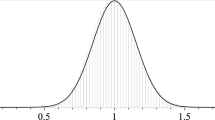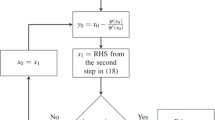Abstract
By restricting Buchberger’s procedure so as to match practical ones and extending the structure of subresultant considerably, we develop a subresultant-like theory for Buchberger’s procedure of Gröbner basis computation. As an application of the theory, we clarify the mechanism of main-term cancellation which is the main origin of instability of the computation of Gröbner bases with floating-point numbers.
Similar content being viewed by others
References
Buchberger, B.: Gröbner bases: an algorithmic method in polynomial ideal theory. In: Bose, N.K. (ed.) Multidimensional Systems Theory, Chap. 6. Reidel Publ., Dordrecht (1985)
Collins J.E.: Subresultant and reduced polynomial remainder sequence. J. ACM 14, 128–142 (1967)
Cox D., Little J., O’Shea D.: Ideals, Varieties, and Algorithms. Springer, New York (1997)
Faugère J.-C.: A new efficient algorithm for computing Gröbner bases (F 4). J. Pure Appl. Algebra 139, 61–88 (1999)
Hearn, A.C. : (1979) Non-modular computation of polynomial GCDs using trial division. In: Proceedings of EUROSAM 79. LNCS, vol. 72, pp. 227–239. Springer, Berlin
Lazard, D.: Gröbner bases, Gaussian elimination and resolution of systems of algebraic equations. In: Proceedings of EUROCAL 1983. LNCS, vol. 162, pp. 146–156. Springer, Berlin (1983)
Loos, R.: Generalized polynomial remainder sequences. In: Buchberger, B., Collins, G.E., Loos, R. (eds.) Computer Algebra, Symbolic and Algebraic Computation. Springer, Berlin (1983)
Mandache, A.M.: The Gröbner basis algorithm and subresultant theory. In: Proceedings of ISSAC’94 (Intn’l Symposium on Symbolic and Algebraic Computation), pp. 123–128. ACM Press, New York (1994)
Sasaki, T.: A practical method for floating-point Gröbner basis computation. In: Proceedings of Joint Conf. of ASCM 2009 and MACIS 2009. COE Lecture Note, vol. 22, pp. 167–176, Kyushu Univ. (2009)
Sasaki T., Furukawa A.: Secondary polynomial remainder sequence and an extension of subresultant theory. J. Inf. Proces. 7, 175–184 (1984)
Sasaki T., Furukawa A.: Theory of multiple polynomial remainder sequence. Publ. RIMS (Research Inst. for Math. Sci., Kyoto Univ. 20, 367–399 (1984)
Sasaki, T., Kako, F.: Computing floating-point Gröbner base stably. In: Proceedings of SNC2007 (Symbolic Numeric Computation), pp. 180–189, London, Canada (2007)
Sasaki, T., Kako, F.: Floating-point Gröbner basis computation with ill-conditionedness estimation. In: Kapur, D. (ed.) Proceedings of ASCM2007 (Asian Symposium on Computer Mathematics). LNAI, vol. 5081, pp. 278–292. Springer, Berlin (2008)
Sasaki, T., Kako, F.: Term cancellations in computing floating-point Gröbner bases. In: Proceedings of CASC2010 (Computer Algebra in Scientific Computing). LNCS, vol. 6244, pp. 220–231. Springer, Berlin (2010)
Author information
Authors and Affiliations
Corresponding author
Additional information
This work was supported in part by Japan Society for the Promotion of Science under Grants 23500003.
About this article
Cite this article
Sasaki, T. A subresultant-like theory for Buchberger’s procedure. Japan J. Indust. Appl. Math. 31, 137–164 (2014). https://doi.org/10.1007/s13160-013-0133-1
Received:
Revised:
Published:
Issue Date:
DOI: https://doi.org/10.1007/s13160-013-0133-1




